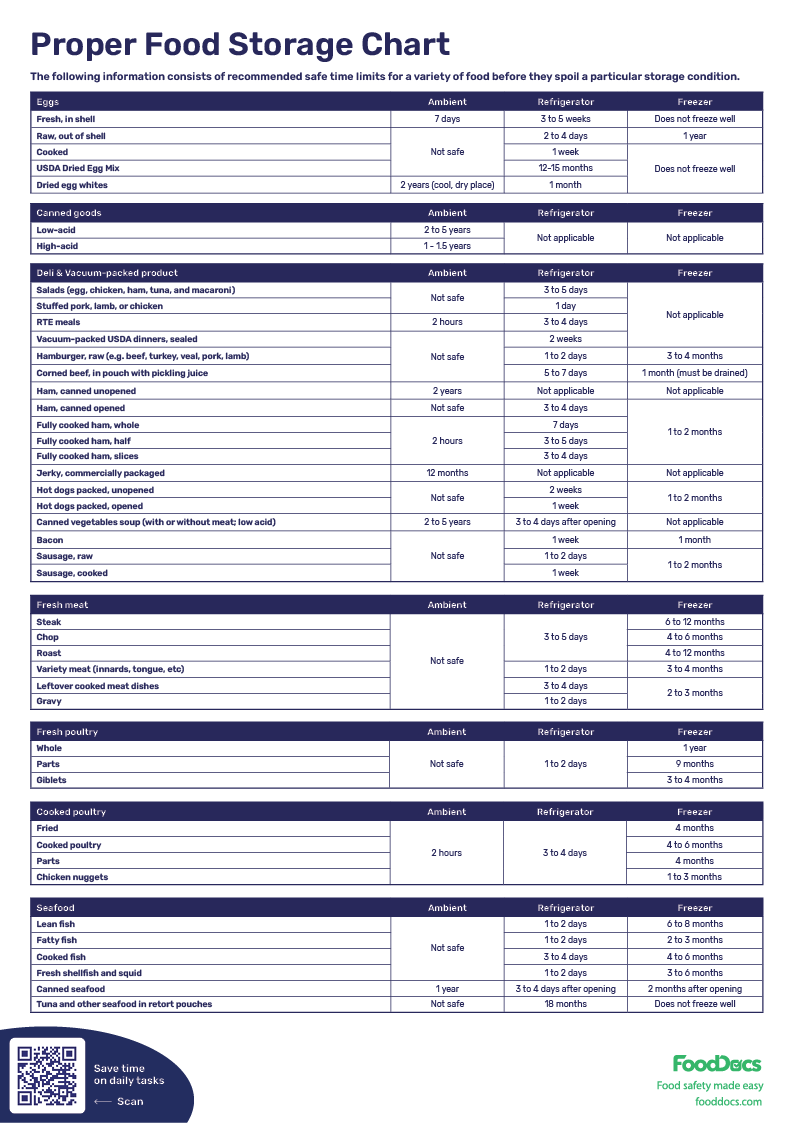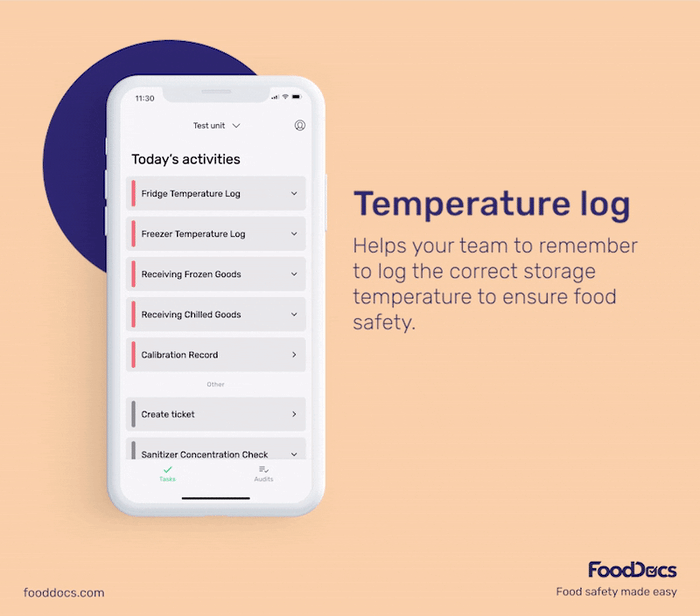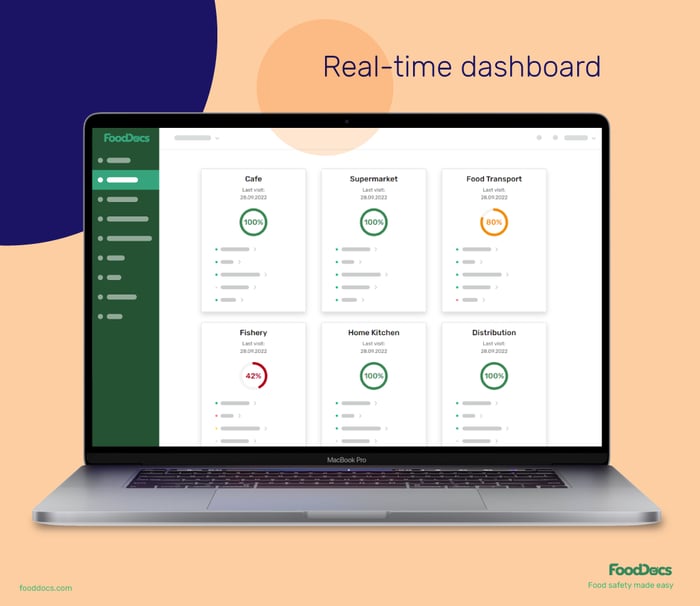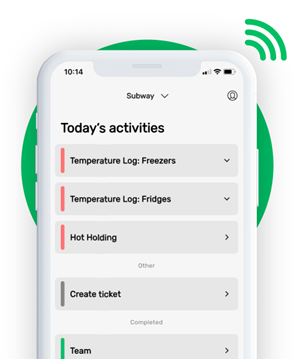PROPER FOOD STORAGE TEMPERATURE CHART


This is how our Digital Food Safety platform saves 20% of your time on daily tasks:
- Get upcoming task notifications
- Add data into the app
- Check the status of tasks in real-time

When food safety was still handled on paper, I typically spent a couple of hours per day getting the papers and going around checking or completing tasks… Now I can sit down and it's just all there in one place. It takes me 5-10 minutes.
Ruth B.
Store Manager
How to use the Proper Food Storage Chart?
A proper food storage chart may be one of the most information-rich charts in the food industry. Making one from scratch can be tricky and will require a lot of time for preparation.
FoodDocs is here to the rescue! You can simply download our proper food storage chart for free and use it for your team's convenience.
This food storage chart is one of our many food safety resource materials. Under our Template hub, we've collated the most significant charts, posters, checklists, and other templates for food businesses.
Make sure to check them out, because in a food business, there can never be too many food safety instruction materials.
Here is a clear guide to using our Proper Food Storage Chart
- Familiarize the chart. Read the chart carefully.
- Enter a valid email address.
- Download the chart. The Proper Food Storage Chart will automatically be sent to the downloads folder on your computer.
- Orient your team about the chart.
- Pin the chart in a visible spot in all of your storage areas.
Ensure all food handlers understand how to use the chart to maximize its benefits.
Get a more intuitive solution for maintaining food safety compliance on proper storage through FoodDocs' smart Food Safety Management System. Use our software's intelligent solutions to make monitoring more convenient and efficient.
Navigating the Proper Food Storage Chart: Your Ultimate Guide to Food Safety Fridge Storage
Proper food storage is key for prolonging the shelf-life of foods and is an important aspect of food safety.
The shelf life of food may depend on several different factors. The only way to maximize their shelf life is to determine their correct storage conditions.
When foods are correctly stored, food businesses can stock fresh ingredients, buy in bulk, save on transportation costs, and carry a continuous food service. Additionally, proper food storage reduces the risk of causing foodborne illnesses.
With the principles of correct storage conditions, food handlers can keep the safety of any perishable food for a long time. To maximize the shelf life of every ingredient, you can use a proper food storage chart as a guide.
Key points covered:
- Proper food storage refers to the process of protecting foods from food hazards and extending their shelf-life.
- Proper food storage is a critical part of correct food handling.
- A Proper Food Storage chart helps preserve food in terms of safety and quality, maintain compliance with regulations, and save the business from unnecessary costs from wastage.
- All food handlers must know and understand proper food storage rules.
- FoodDocs' smart Food Safety Management System features an automatically generated and customizable Temperature Log that can be used to monitor storage conditions.
- Our smart software also features a real-time dashboard that can save the manager's time from supervising their teams.
WHAT WE'LL COVER:
- Proper Food Storage Chart definition
- Who needs the chart?
- Benefits of the Proper Food Storage Chart
- Important food storage guidelines
- Digital solution to managing proper food storage
- Temperature log that helps ensure proper food storage
- Customizable food safety system that helps integrate improvements
- Real-time overview that saves every manager's time from supervision
- Step-by-step instructions that help in training food handlers
- Frequently Asked Questions
What is a Proper Food Storage Chart?
A food storage chart or a food shelf life chart is a useful reference tool that can be used to determine the estimated shelf life of foods when stored at ambient, refrigerated, and freezing temperatures.
This chart can help food handlers determine which storage conditions and proper temperatures would be most suitable for storing foods.
A proper food storage chart is an integral part of your basic food safety management system (FSMS) and help in managing the shelf life of your raw ingredients.
Ensure consistently maintained storage temperature for your raw materials and products with the help FoodDocs' smart Food Safety Management System. When you use our smart software, you can get intuitive monitoring tasks, such as our Temperature Log. You can use this digital monitoring task to record storage temperatures through our food safety app.
Learn more in the next parts of this article.
How does proper storage affect food shelf life?
Depending on internal and external factors, different foods may have different shelf life.
Common foods with less available water are more likely to stay safe longer than those with a lot of moisture.
For example, dried foods with high salt content are less likely to be spoiled than raw meat or fresh vegetables. Some foods can be more tolerant and less likely to be affected by the temperature danger zone, whereas some can be more sensitive.
Additionally, acidic foods are generally more stable than foods with low acids. This is because harmful bacteria and parasites cannot survive high-acid conditions. In this case, other factors, such as food temperature, must be controlled to prevent other pathogens like molds from spoiling the food. At these safe temperatures, cold foods can stay fresh longer without fearing spoilage.
Generally, refrigerated foods can last longer than those stored in ambient temperatures. Keeping food cold slows down the growth of bacteria and allows food handlers to use these raw foods for later preparation. Refrigeration or controlled safe temperature storage is very helpful in keeping highly perishable products such as dairy products, salad dressings, raw meat (e.g., whole and ground meats), vegetables, fresh fish, and fruits.
Who needs a Proper Food Storage Chart?
Any food establishment in the industry can use a proper food storage chart. The food storage chart contains an extensive amount of information and may help food establishments, such as:
- food production and manufacturing;
- restaurants and food service;
- food retail and grocery stores;
- institutional food service (e.g., cafeterias and hospitals); and
- raw material producers.
Whether your food business specializes in only a few dishes or offers a wide range of products, your team will surely find this chart useful.
What are the benefits of a Proper Food Storage Chart?
Proper food storage is a critical food safety practice and a very important aspect of food service. When a food service operator can properly control a good storage environment, they can assure food safety and prevent serving any harmful foods to customers that can increase the risk of food poisoning. Additionally, a proper food storage chart can offer different benefits for food service teams.
Below we list 7 benefits of a Proper food storage chart.
- Food safety. The main benefit of a proper food storage chart is that it helps ensure food safety by providing clear guidance on the best conditions for storing food. The chart can help reduce the likelihood of contamination and spoilage of food caused by bacteria and other harmful pathogens.
- Extended shelf life. Following proper food storage guidelines helps to extend the shelf life of perishable items. This reduces food waste and saves money for households, businesses, and organizations by preventing premature spoilage.
- Reference guide. The main purpose of a proper food storage chart is to serve as a reference for food handlers regarding the shelf life of foods. This chart can help your team determine in which conditions you should keep your raw ingredients and how long they will last. A proper food storage chart also considers ready-to-eat foods and partially cooked ingredients.
- Reminder. A glance at a proper food storage chart can remind food handlers whether food is almost past its expiration date and needs to be immediately used or if it can still last a few more days.
- Maintained food quality. This is a great advantage for food handlers as your team can ensure that no food will spoil and go to waste. Additionally, it can help your team only use the freshest ingredients for high-quality foods.
- Cost-saving. In addition to reducing food waste, a proper food safety chart can help your team plan which ingredients to buy first and in bulk. In other words, this chart can help you decide whether it is economical to stock up on several packs of cured meat or to spend another trip to the food market to buy in portions.
- More organized storage. A proper food storage chart also tells you whether it would be better to just cool foods or put your products in the freezer. Frozen foods are less likely to be contaminated and spoiled by dangerous bacteria. Use a proper food storage chart to decide and organize in which storage conditions you should put your foods.
The only way to maximize their shelf life is to determine their correct storage conditions.
When foods are correctly stored, food businesses can stock up on fresh ingredients, buy in bulk, save on transportation costs, and carry a continuous food service. Additionally, proper food storage reduces the risk of causing foodborne illnesses.
A Proper Food Storage Chart can become a variable resource that promotes safety and a cost-effective food system. In addition to this chart, you can get smart solutions from FoodDocs. You can use our smart Food Safety Management System, which features detailed instructions on every monitoring task to guide food handlers in storing foods properly.
What are important food storage guidelines?
Proper food storage is essential for maintaining the safety of foods in any food business. To become effective, there are several guidelines that every food handler must follow.
Here are some key steps to follow when storing food:
- Keep foods away from the temperature danger zone (40°F to 140°F or 4°C to 60°C) to prevent bacterial growth.
- In any storage area, separate raw and cooked foods to avoid cross-contamination.
- Keep raw foods in airtight, food-grade containers or proper wrapping to protect them from contamination.
- Keep cold food cold and hot food hot.
- Always check use-by or expiration dates.
- Practice First-In, First-Out.
- Keep all storage areas clean and sanitized.
- Practice proper date labeling of foods.
- Monitor the temperature and humidity of the storage area consistently.
- Immediately refrigerate fresh foods within the first two hours after purchase.
- Practice proper organization of foods. Use a Fridge Organization Chart.
- Dispose of expired foods immediately.
- Practice rapid cooling before refrigerating freshly cooked foods.
- Avoid overcrowding storage areas.
- Inspect storage areas for the presence of pests.
These rules on food storage are just some of the most common and basic food storage practices. Consistent monitoring of these practices is a must to ensure food safety. Use FoodDocs' intuitive Food Safety Management System that helps every food handler remember which food storage guidelines must be done to maintain food safety daily.
What are the 5 factors that affect safe food storage?
Food storage is an essential aspect of food safety. Understanding and implementing the principles of safe food storage is essential for both individuals and food businesses alike.
To better understand the factors that must be controlled during food storage, here are 5 essential principles:
- Temperature control. Factors that can cause contamination and spoilage during storage are significantly affected by temperature. Generally, food businesses must always keep food from the temperature danger zone. The best practice for storing perishable foods would be to keep them in cold storage or hot holding, whichever is more suitable.
- Cross-contamination prevention. Practices such as storing foods in airtight containers and organizing them during storage aim to prevent cross-contamination. Foods will surely come in contact with each other during storage. As such, cross-contamination must be prevented at all costs.
- Cleaning and sanitation. Maintain hygienic practices during food storage. Wash your hands thoroughly before handling food, and ensure all food storage containers, utensils, and surfaces are clean and sanitized. This helps prevent the introduction of harmful bacteria and other contaminants.
- Labeling and rotation. Refrigeration will not keep your food ingredients from spoiling. This task can only prolong their shelf-life. As such, properly label food containers with their contents and storage dates. Implement the "First In, First Out" (FIFO) method to use older food items before newer ones. This practice helps ensure that perishable items are consumed or disposed of before they become spoiled or unsafe.
- Proper packaging. Proper packaging protects foods from contamination and environmental changes affecting their quality. Use airtight containers, resealable bags, or appropriate wrapping materials designed for food storage.
By following these principles of safe food storage, you can significantly reduce the risk of foodborne illnesses, maintain the quality of your food items, and minimize waste.
How to help your team manage food safety with proper storage?
Several factors need to be monitored to keep foods safe in the correct food storage conditions. The temperature checks and cleanliness of the storage location must always be maintained through regular monitoring to ensure food safety.
What if there was a smarter way to remember all food safety tasks? Luckily, there is! At FoodDocs, we have developed a digital solution to ensure food safety while maintaining proper food storage.
With just a few clicks and answers to our basic questions about your business, you can get the following benefits from our system:
Temperature log that helps ensure proper food storage
Just after setting up the system in 15 minutes, you can get automatically generated monitoring tasks, such as our Temperature log. Use this log through our food safety app to record temperature readings for all storage areas in your food business.
In addition to intuitively generated monitoring tasks, our system features compatibility integrations with smart sensors. Integrate your smart sensors with our system to automatically record temperature readings. This solution does not only save every food handler's time but also supports the accuracy of monitoring tasks.

Customizable food safety system that helps integrate improvements
We understand how different businesses can be. As such, we made our Food Safety System customizable for improvements.
Users can tailor monitoring tasks, checklists, and other food safety information to your business needs.
Incorporate suggestions from food safety audits right away with just a few clicks and consistently maintain compliance with food safety regulations.
Real-time overview that saves every manager's time from supervision
In addition to solutions for your employees, our digital Food Safety Management System also features systems to save every manager's time from supervising.
A real-time dashboard that shows a quick overview of your food safety operations. Save at least 20% of your time supervising your team with this real-time dashboard. This dashboard will show which storage conditions are non-compliant and can help you address them right away.
Maintain proper storage across all of your business branches using this solution.

Step-by-step instructions that help in training food handlers
All generated monitoring tasks from our software come with detailed, step-by-step instructions for each task. Managers can use these instructions to guide food handlers on proper storage.
The instructions are accessible to all users and can be used as a reference to ensure accurate execution of tasks. Managers can customize these instructions by uploading your version as images or videos.
Not only can our system help you maintain compliance, but it can also move your food business toward sustainability. Unlike your traditional monitoring systems and FSMS, our system will not require any paper-based monitoring forms. You can free up the space you used to dedicate for file cabinets and use it for other food service equipment.
Using our system, logging information about your storage conditions and keeping track of your food shelf life can be super easy.
Frequently Asked Questions (FAQs)
What are the 4 main storage areas for food?
In any food business, there are four main storage areas:
- Refrigerator. Used for short-term storage of perishable foods like meat, poultry, fresh fruits, and leftovers.
- Freezer. Used for long-term storage of raw food ingredients.
- Pantry. Used for storing non-perishable foods, such as canned goods, baking ingredients, and grains.
- Dry storage. Refers to a separate area, often in commercial kitchens or larger food establishments, where non-perishable and dry ingredients are stored in bulk.
How important is proper food storage?
Proper food storage is critical for food businesses. It helps ensure food safety for raw and cooked foods and maintains their quality consistently. It reduces the risk of bacterial growth, cross-contamination, and spoilage, which can lead to serious health hazards. Additionally, adhering to proper food storage practices helps minimize food waste and supports cost-effective operations for households, businesses, and organizations.
What is the correct storage order for food?
Properly grouped foods must be placed in a storage area with foods that need extensive cooking at the bottom-most part and the ready-to-eat foods at the top shelf. This arrangement helps prevent cross-contamination among foods, especially from the drippings of raw food. Use our fridge layout food safety poster in combination with a food storage chart to help you manage your foods in the kitchen.














